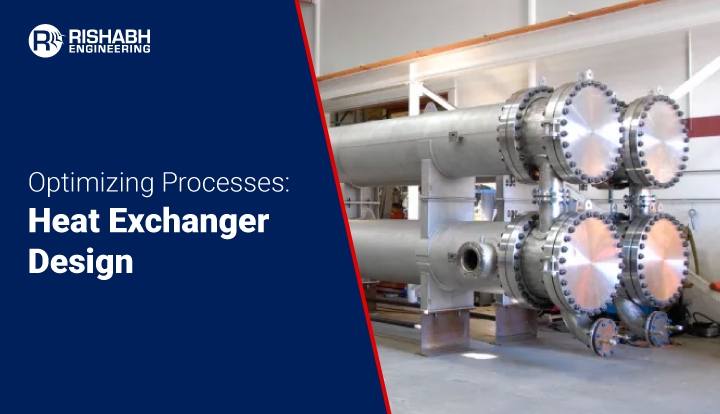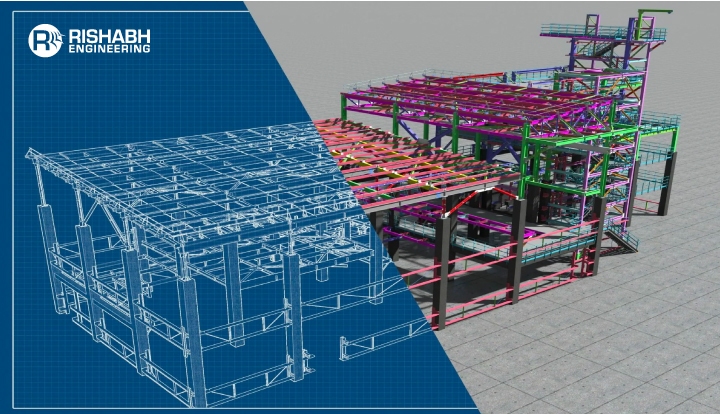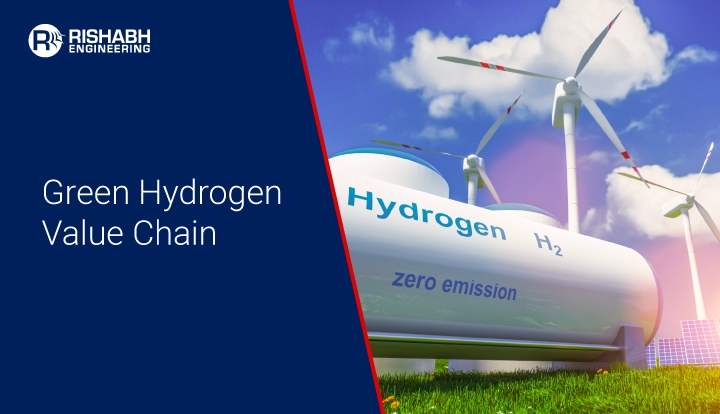
Heat Exchanger Design For Achieving Process Optimization
In the ever-evolving domain of industrial operations, prioritizing energy efficiency is of utmost importance. Central to attaining peak performance are heat exchangers, pivotal devices in this pursuit. This piece delves into the intricacies linked with the heat exchanger design parameters that govern and accentuate the significance of refining processes. The exploration navigates through the fundamental principles shaping heat exchanger design, shedding light on critical elements that bolster advancements in energy efficiency. Real-world case studies from Rishabh Engineering would illustrate the positive results attained through the implementation of optimized heat exchanger systems. Let’s get started!

Understanding Heat Exchanger Design: Fundamentals And Principles
A heat exchanger holds crucial significance in various industrial operations, serving as a pivotal element for transferring heat between multiple fluids. Despite apparent differences in scale, materials, and design intricacies, the primary objective of ensuring efficient heat transfer remains unaltered. The fundamental principle underlying its functionality revolves around the efficient exchange of thermal energy while effectively maintaining the physical separation of the involved fluids. The extensive application of this process spans across diverse industries, including but not limited to petrochemicals, power generation, and manufacturing.
- Examining the analogy between industrial and biological heat exchangers reveals commonalities in function. Both serve the primary purpose of transferring heat between mediums to maintain optimal temperatures for processes or biological functions. The mechanisms of heat transfer, involving conduction, convection, and radiation, are consistent across both domains.
- In the industrial setup, heat exchangers are engineered devices facilitating efficient heat transfer between fluids like water, air, or process fluids. Utilizing networks of pipes or channels, they employ various designs such as shell-and-tube, plate, and finned-tube cross-flow configurations.
- Conversely, in nature, organisms have evolved diverse heat exchange mechanisms to regulate body temperature and optimize metabolic processes. For warm-blooded animals like mammals and birds, blood vessels near the skin surface act as natural heat exchangers. These vessels widen to dissipate heat and narrow to retain it, contributing to the regulation of internal body temperature.
Recognizing the parallels between these two macro classes of heat exchangers not only enhances our understanding but also inspires advancements in heat transfer technologies, benefiting both industrial processes and biological systems. Whether in the intricate designs of industrial heat exchangers or the evolutionary adaptations in natural organisms, the shared principles of efficient heat exchange form the basis for technological innovation and biological survival alike.
Critical Components Of Heat Exchanger Design
- Type of Heat Exchanger: Choosing the right type of heat exchanger is fundamental as each of them with a set of strengths and weaknesses. Further, this would influence factors like how effectively heat is transferred and the maintenance needs.
- Material Selection: The selection of materials is pivotal in ensuring the longevity and reliability of a heat exchanger. It would include parameters like operating fluids, resistance to corrosion, thermal conductivity and more.
- Fluid Selection: The choice of fluids circulating through the heat exchanger significantly influences efficiency. Engineers must consider the thermal properties, corrosiveness, and other fluids’ characteristics.
- Flow Configuration: The arrangement of fluid flow paths within the heat exchanger can impact its effectiveness. Parallel or counterflow configurations influence temperature differentials and heat transfer rates, directly affecting overall performance.
- Heat Transfer Surface Area: Calculating and optimizing the heat transfer surface area is critical for achieving desired performance levels. This task revolves around finding a delicate equilibrium between ensuring effective heat exchange and addressing real-world concerns tied to limitations in space and budget considerations.
- Tube or Channel Geometry: The geometric design of heat exchanger tubes or channels affects fluid flow patterns and heat transfer characteristics. Achieving the perfect equilibrium between turbulence and pressure drop proves crucial in optimizing the efficiency of heat transfer.
- Temperature and Pressure Considerations: Operating conditions, including temperature and pressure ranges, must be carefully considered during the design phase.
- Maintenance Accessibility: Easy access for inspection and maintenance is often overlooked but is critical for the sustainable operation of a heat exchanger.
The Role Of Heat Exchangers In Maximizing Energy Efficiency
- Minimizing Energy Consumption: Heat exchangers play a crucial role in curbing energy usage by effectively transferring heat between different process streams. This holds particular significance in industries with substantial energy demands.
- Utilizing Residual Heat: Heat exchangers play a vital role in capturing and repurposing heat that would otherwise go to waste in diverse industrial operations, transforming it into valuable energy.
- Temperature Precision: Maintaining precise temperature control is crucial in various industrial settings.
- Optimizing Process Efficiency: A thoughtfully engineered heat exchanger significantly contributes to the overall improvement of industrial processes.
Types Of Heat Exchanger Design
With heat exchanger design, a diverse array of configurations has emerged, each tailored to specific industrial needs. Understanding these variations is crucial for optimizing thermal processes and maximizing energy efficiency.
Listed below are the types of heat exchanger designs:
- Tubular and Shell Heat Exchanger: This traditional configuration involves a shell housing multiple tubes, facilitating heat exchange between fluids. This adaptability enables versatility across various applications, from generating power to crafting chemicals and more.
- Double Pipe or Hairpin Exchanger: Distinguished by a U-shaped tube bundle within a shell, this design prioritizes simplicity and ease of maintenance. This helps achieve optimal efficiency while maintaining a streamlined and compact structure.
- Flat Plate and Fin Heat Exchangers: Employing thin plates and fins to improve heat transfer, this design is commonly utilized in HVAC systems and refrigeration units.
- Radiators and Solar Exchangers: Well-known in automotive applications, radiators use a combination of tubes and fins for heat dissipation.
- Spiral Heat Exchangers: Characterized by a spiral design ensuring continuous and efficient fluid flow, this configuration minimizes fouling and enhances heat transfer. It proves particularly effective in applications involving viscous or fouling fluids.
How To Design A Heat Exchanger?
The design of an effective heat exchanger would require a systematic approach to help transfer thermal energy among diverse fluids. Based on our practical experience, here’s an outline of the key steps involved in the design process:
- Define Requirements: Clearly articulate the purpose of the heat exchanger, considering factors such as fluid types, flow rates, temperature differentials, and desired energy transfer efficiency. A tailored design would rely on a thorough understanding of specific requirements.
- Select Heat Exchanger Type: Opt for the most suitable heat exchanger type based on the application’s demands. While there exist various types of heat exchangers, each of them is designed with unique features that cater to specific needs and factors such as pressure, temperature, spatial limitations and more.
- Fluid Selection: Thoughtfully choose the fluids circulating through the heat exchanger, factoring in their thermal properties, corrosiveness, and compatibility. This selection significantly influences overall efficiency and longevity.
- Determine Surface Area: The critical parameter of available surface area for heat transfer demands optimization. Engineers fine-tune this area based on specific heat transfer requirements, ensuring an efficient thermal exchange between the involved fluids.
- Configure Flow Paths: Clearly define the flow paths for both hot and cold fluids within the heat exchanger. This entails deciding on the arrangement of tubes, plates, or fins to facilitate effective heat transfer.
- Temperature Approach: It represents the temperature difference between hot and cold fluids. A smaller temperature approach generally results in higher heat transfer efficiency.
- Material Selection: Select materials capable of withstanding operational conditions and ensuring durability. It is vital to consider factors like corrosion resistance and thermal conductivity.
- Performance Evaluation: Employ simulation tools or software to assess the performance of the designed heat exchanger across various operating conditions. This step aids in refining the design for optimal efficiency.
- Prototyping and Testing: Construct a prototype based on the final design and conduct testing to validate its performance. Modifications can be applied by considering test outcomes and enhancing the heat exchanger to better suit practical scenarios. This process allows for adjustments that align more closely with real-world conditions.
Process Optimization Through Multidisciplinary Engineering
Utilizing multidisciplinary engineering proves crucial in optimizing heat exchanger design processes. Incorporating the above-listed process could help encompass thermal efficiency. Further, this collaborative initiative would strengthen the design’s durability, leading to enhanced performance and longevity. And ultimately contributing towards the overall efficiency and sustainability of heat exchange processes.
Key Contributions Of Multidisciplinary Engineering Firms
- Comprehensive Design Expertise: Rishabh Engineering brings together a team of experts in process, mechanical, electrical, and instrumentation engineering that allows them to offer a comprehensive approach to heat exchanger design.
- Customized Solutions: Rishabh Engineering excels in crafting tailored solutions that meet the specific needs of major companies in the energy sector while integrating industry-specific requirements and ensuring required compliance and efficiency.
Success Stories
Case 1: Design & Detailed Drawings for AXS type Heat Exchanger
Challenge: Designing and generating detailed drawings for an AXS Heat Exchanger that complies with ASME Sec. VIII Div. 1 Ed. 2010 and TEMA Class R (U-stamp), including General Arrangement (GA) and Fabrication drawings.
Solution: We helped the client with the design and development of detailed drawings for Floating Head HX (u-stamp) with Multiple Passes. Our committed team for this project comprised an Engineer, a Lead Designer, and a Designer who employed software tools, like HTRI, ASPEN Plus, Intergraph PV Elite, and Autodesk AutoCAD. The initiative, undertaken by a renowned global manufacturer and supplier specializing in heat transfer equipment, focused on enhancing the safety and security of the heat exchanger design. The primary goal was to optimize the project by standard codes and specifications, ensuring compliance with industry regulations.
Deliverables:
- Detailed Drawings for various Heat Exchanger components
- General Arrangement & Fabrication Drawings
- Major Design Review
- WRC Calculations for process Nozzles/Lifting Lugs
- Bill of Materials
Case 2: Mechanical Design Calculations and Detail Drawing For Shell and Tube Heat Exchanger
Challenge: A US-based client who owns and manages a prominent chocolate manufacturing facility sought a comprehensive design and construction solution for a Shell and Tube Heat Exchanger for one of their upcoming facility.
Solution: Rishabh Engineering took on the responsibility of calculating mechanical designs and conducting detailed drawings For Shell and Tube Heat Exchangers.
It was based on the following parameters:
- Heat Exchanger Dimensions: 12’’X144″
- Shell Side Conditions: 95 psim @ 680oF
- Tube Side Conditions: 75 psi @ 600oF
By leveraging its expertise, our team provided a comprehensive solution, ensuring the successful design and build of the Shell & Tube Heat Exchanger, meeting the client’s specifications and requirements.
Final Words
Maximizing energy efficiency through process optimization with heat exchanger design is crucial for industries worldwide. Multidisciplinary engineering firms like Rishabh Engineering play a pivotal role in this journey, offering comprehensive solutions that address the unique challenges of each industrial setting. These firms contribute significantly to creating a sustainable and efficient future for industrial processes by integrating intelligent design practices, customized solutions, and real-world case studies.
With dedicated static equipment engineering services comprised of the design and analysis of pressure vessels, storage tanks, heat exchangers, and boilers we support a wide range of projects for customers from varied industries. Embracing optimized heat exchanger systems reduces energy consumption and aligns with global environmental responsibility and resource conservation efforts.
Seek Help With Heat Exchanger Design?
Elevate heat exchanger design with Rishabh Engineering’s expertise. We can help optimize efficiency and performance effortlessly.
Related Blogs
Related Blogs
Best Structural Engineering Software for Accurate Analysis
Finding tools that simplify and improve the accuracy of the…
Detailed Engineering Considerations for Project Success
Engineering projects today require meticulous planning and execution across various…


